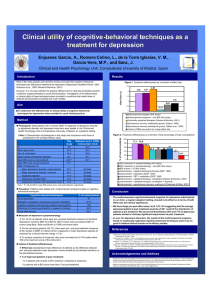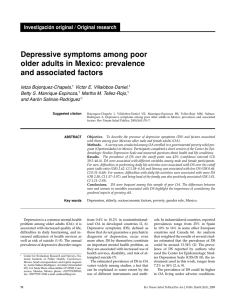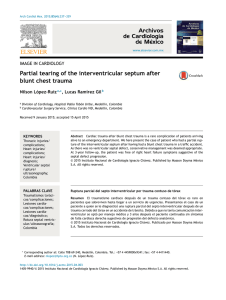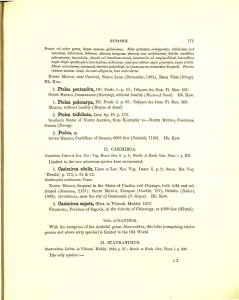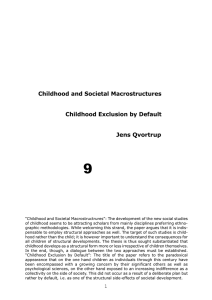Childhood trauma is associated with depressive
Anuncio
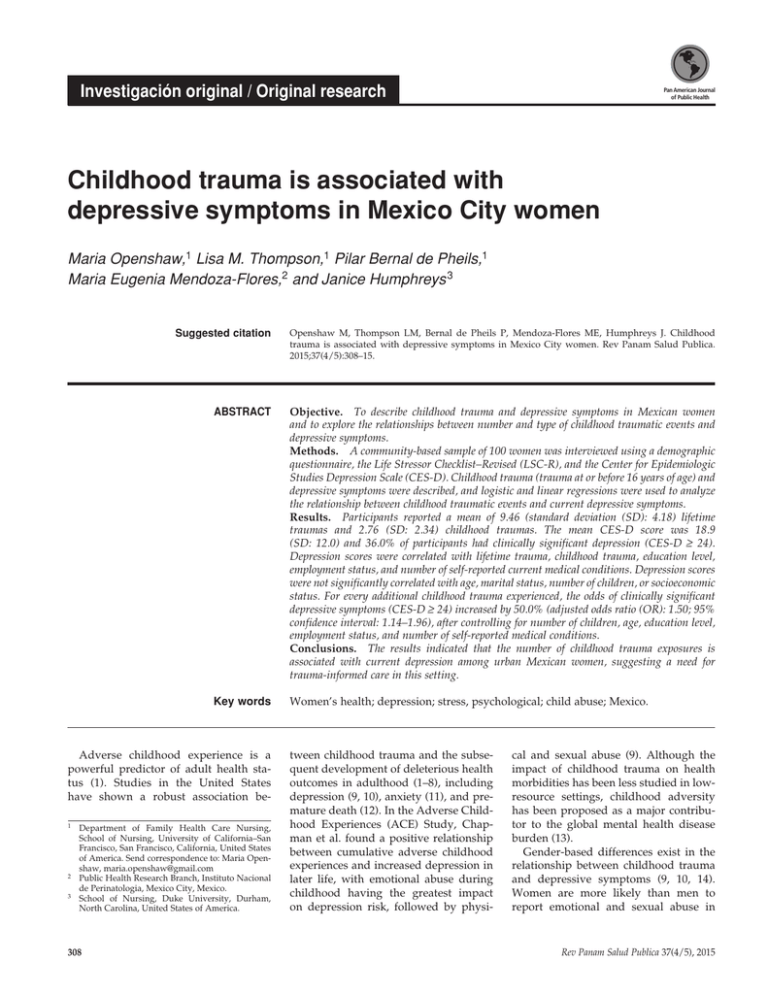
Investigación original / Original research Pan American Journal of Public Health Childhood trauma is associated with depressive symptoms in Mexico City women Maria Openshaw,1 Lisa M. Thompson,1 Pilar Bernal de Pheils,1 Maria Eugenia Mendoza-Flores,2 and Janice Humphreys 3 Suggested citation Openshaw M, Thompson LM, Bernal de Pheils P, Mendoza-Flores ME, Humphreys J. Childhood trauma is associated with depressive symptoms in Mexico City women. Rev Panam Salud Publica. 2015;37(4/5):308–15. abstract Objective. To describe childhood trauma and depressive symptoms in Mexican women and to explore the relationships between number and type of childhood traumatic events and depressive symptoms. Methods. A community-based sample of 100 women was interviewed using a demographic questionnaire, the Life Stressor Checklist–Revised (LSC-R), and the Center for Epidemiologic Studies Depression Scale (CES-D). Childhood trauma (trauma at or before 16 years of age) and depressive symptoms were described, and logistic and linear regressions were used to analyze the relationship between childhood traumatic events and current depressive symptoms. Results. Participants reported a mean of 9.46 (standard deviation (SD): 4.18) lifetime traumas and 2.76 (SD: 2.34) childhood traumas. The mean CES-D score was 18.9 (SD: 12.0) and 36.0% of participants had clinically significant depression (CES-D ≥ 24). Depression scores were correlated with lifetime trauma, childhood trauma, education level, employment status, and number of self-reported current medical conditions. Depression scores were not significantly correlated with age, marital status, number of children, or socioeconomic status. For every additional childhood trauma experienced, the odds of clinically significant depressive symptoms (CES-D ≥ 24) increased by 50.0% (adjusted odds ratio (OR): 1.50; 95% confidence interval: 1.14–1.96), after controlling for number of children, age, education level, employment status, and number of self-reported medical conditions. Conclusions. The results indicated that the number of childhood trauma exposures is associated with current depression among urban Mexican women, suggesting a need for trauma-informed care in this setting. Key words Women’s health; depression; stress, psychological; child abuse; Mexico. Adverse childhood experience is a powerful predictor of adult health status (1). Studies in the United States have shown a robust association be1 Department of Family Health Care Nursing, School of Nursing, University of California–San Francisco, San Francisco, California, United States of America. Send correspondence to: Maria Openshaw, [email protected] 2 Public Health Research Branch, Instituto Nacional de Perinatologia, Mexico City, Mexico. 3 School of Nursing, Duke University, Durham, North Carolina, United States of America. 308 tween childhood trauma and the subsequent development of deleterious health outcomes in adulthood (1–8), including depression (9, 10), anxiety (11), and premature death (12). In the Adverse Childhood Experiences (ACE) Study, Chapman et al. found a positive relationship between cumulative adverse childhood experiences and increased depression in later life, with emotional abuse during childhood having the greatest impact on depression risk, followed by physi- cal and sexual abuse (9). Although the impact of childhood trauma on health morbidities has been less studied in lowresource settings, childhood adversity has been proposed as a major contributor to the global mental health disease burden (13). Gender-based differences exist in the relationship between childhood trauma and depressive symptoms (9, 10, 14). Women are more likely than men to report emotional and sexual abuse in Rev Panam Salud Publica 37(4/5), 2015 Openshaw et al. • Association between childhood trauma and depression in Mexico City women childhood, and also report a greater intensity of emotional abuse (11). Similarly, women are more likely to report prior or current depression, and adverse childhood experiences appear to have a greater influence on depression rates in women (9). It is unclear whether this differential response is related to different rates of exposure or neurobiological differences in the stress response (10). Stressful lifetime events and environmental adversity, particularly childhood sexual abuse, are among the strongest predictors of depressive episodes in adult women (15). Finally, physiologic differences related to hypothalamic– pituitary–adrenal (HPA) axis dysregulation in depressed women as well as variability in estrogen and other steroid levels (as shown by cyclical depression in women as well as increased rates at menarche and menopause) may play a role in gender differences in depression (14). These pathways, however, continue to be poorly understood. Although the biology of depression should be consistent across all populations, the relative contribution of environmental and social stressors can vary greatly. Therefore it is less clear whether predictive models developed in the United States are meaningful in evaluating depression in women in other countries. The relationship between childhood trauma and mental health problems, including depression, was found to be robust in two communitybased studies in Chile (16) and Australia (17). The World Health Organization World Mental Health Surveys (13), conducted in 21 countries, including the United States and Mexico, estimated that childhood adversity accounted for 29.8% of mental health disorders worldwide, although the relationship between adversity and individual psychiatric disorders was not described. The strongest predictor of mental health disorders was maladaptive family functioning, including domestic violence, physical and sexual abuse, and neglect (13). Mexico City context Depression-related morbidity is a significant health issue for urban Mexican women. The largest survey conducted on mental illness in Mexico, the Mexican National Comorbidity Survey (18), suggests that Mexican women have a 26.1% lifetime prevalence of psychiatric disor- Rev Panam Salud Publica 37(4/5), 2015 ders, including an estimated prevalence of 9.2% for any mood disorder and 14.3% for any anxiety disorder. Mental health disorders and depression are more prevalent in Mexican women than Mexican men (18, 19). In one urban sample, the lifetime prevalence of major depressive disorder (MDD) was 15.9% for women and 9.0% for men; in that study, additional predictors of MDD included age, marital status, years of residence, and city of residence (19). Potentially traumatizing events are common across the lives of Mexican women. In a study that assessed the prevalence of traumatic events and posttraumatic stress disorder (PTSD) among 2 509 urban Mexicans, 76% reported lifetime exposure to potentially traumatic events (20). Most participants reported multiple traumatic events, with 27% reporting four or more traumatic events; 7% met the criteria for chronic PTSD (20). However, the relationship between trauma exposure and PTSD diagnosis differed by sex and socioeconomic status. While trauma exposure was more common for men, rates of PTSD were higher among women. Although socioeconomic status did not influence exposure to trauma, subsequent PTSD was more common in individuals with low educational attainment and low socioeconomic status (20), suggesting that contextual variables may mediate or moderate the relationship between stressful events and subsequent mental health outcomes. A secondary analysis of these data found that mental health status may modify the relationship between childhood trauma and poor adult physical health (21). This may explain the increased reporting of psychological and physical morbidity among women with a history of childhood trauma. Although trauma- and depressionrelated morbidity in Mexican women is high, these conditions are widely undertreated. According to the Mexican National Comorbidity Survey (22), resources for mental health treatment are limited in Mexico. Only 24.7% of women with a major depressive episode seek treatment within 12 months, with lower rates of treatment in subgroups including young adults (22). There is a tremendous unmet need for psychiatric treatment, with underutilization of the services that do exist (23). Understanding the complex relationships between childhood trauma and Original research mental health disorders (including depression) is a necessary precursor to the development, implementation, and utilization of needed mental health services. The purpose of this study was to explore the relationship between traumatic events in childhood and the presence of depressive symptoms in a communitybased sample of women from diverse ­socioeconomic strata living in five districts of Mexico City. A secondary aim was to describe the number and types of childhood traumatic events and the prevalence of depressive symptoms in this sample. The authors’ hypothesis is that women who report a greater number of childhood traumatic events will also report current depressive symptoms. MATERIALS AND METHODS This paper is a secondary analysis of a cross-sectional study conducted in 2013. The authors recruited a communitybased sample of 100 women living in the five most populous districts of Mexico City. In collaboration with district health centers, collectors used census tracts (Áreas geoestadísticas básicas, AGEBs) from the National Institute of Statistics and Geography (Instituto Nacional de Etadística y Geografía, INEGI) to select neighborhoods representative of each district’s socioeconomic composition. The sample was stratified by neighborhood socioeconomic level in order to recruit women representative of each district. In selected neighborhoods, all homes were visited sequentially. Eligible participants were Spanish-speaking women 18 years or older who had ever experienced trauma. Data collectors visited a total of 716 homes. In 303 homes, there was no woman present in the home who met the study criteria. Of the remaining 413 homes, 100 (24.2%) agreed to participate. Ethical approval Prior to data collection, approval was obtained from the University of California–San Francisco (UCSF) Committee on Human Research and the Mexico City Federal District Secretary of Health. Enrolled women provided written and verbal consent. Procedures Mexican nurses served as data collectors. They recruited participants by 309 Original research going door-to-door and conducted interviews in the women’s homes. Interviews included demographic and general health information and standardized questionnaires about depressive symptoms, PTSD symptoms, chronic pain, and stressful events during the woman’s lifetime. Each interview lasted approximately one hour. Due to the sensitive nature of the interviews, the women were also asked to rate their stress level at the beginning and end of each interview to ensure that they were not being caused undue distress. All participants were given information on community resources related to trauma and mental health. Any woman who reported distress was offered referral to a trained psychologist. No participant required mental health counseling as a result of the interview. Demographic questionnaire A demographic questionnaire designed by the senior author was collected at the start of each interview and included age, district of residence, marital status, number of children, employment and type of job, education level, and family income. The women were asked about pregnancy status, and history and treatment of any medical conditions, and were instructed to rank their current health status on a scale of 0–10 (“self-reported health score”). Interviewers assigned each respondent a socioeconomic status (SES) (low, middle, or high) based on census information acquired from district health centers. Center for Epidemiologic Studies Depression Scale The Center for Epidemiologic Studies Depression Scale (CES-D) was used to assess depressive symptoms (24). This short self-report scale includes 20 items assigned a score of 0–3 points based on frequency of depressive symptoms in the past week. A positive CES-D screen is strongly correlated with clinical depression across age, sex, and SES (24). The CES-D has also been validated for evaluation of depressive symptoms in Spanish-speaking populations. A systematic review of depression-screening instruments for Spanish-speaking primary care patients found that the diagnostic accuracy of the 20-item CES-D compared favorably with other compa- 310 Openshaw et al. • Association between childhood trauma and depression in Mexico City women rable instruments at detecting clinical depression, with a sensitivity ranging from 76% to 92% and a specificity between 70% and 74% (25). The cutoff point for a positive CES-D screen is typically 16 out of 60 points, based on the upper quintile in U.S. community-based populations (24). However, studies have reported higher scores in Latino populations, suggesting that 24 may be a more appropriate threshold for clinically significant depression in some populations (26, 27). Therefore, a threshold of CES-D score ≥ 24 was also evaluated as the dependent variable for this study, indicating current symptoms consistent with clinical depression. Life Stressor Checklist–Revised Trauma exposure was surveyed using the Life Stressor Checklist–Revised (LSC-R), a standardized self-report instrument designed by Wolfe et al. (28) to measure lifetime trauma exposure in women. Diverging from previous PTSD measures that focus on combat-related trauma, and recognizing that PTSD may manifest differently in women, the instrument targets events of specific importance to women such as pregnancy loss and severe handicap or illness of a child (29). The checklist includes 28 discrete events as well as an option for “Other” and an option for being distressed about an event experienced by another person but not witnessed by the respondent (28). A maximum score of 30 would indicate exposure to every type of trauma described. Follow-up questions assess the age at which each event was experienced and the degree of stress and fear produced by the event, allowing the instrument to be scored for presence of PTSD. The Spanish-language adaptation by Humphreys et al. (30) includes the number of occurrences for each event in order to differentiate between occasional and chronic exposures. The LSC-R has been found to be stable in the assessment of trauma in women (kappa: 0.52–0.97; percentage of item agreement: 79%–98%) (29). A study of the construct validity and cultural appropriateness of the Spanish translation of the LSC-R found the instrument to be valid, easily understood, and culturally appropriate in a community-based sample of Colombian women (30). In the study reported here, the primary independent variable was the number of traumatic events experienced at or before 16 years of age. Because of the personal nature of the questions, the LSC-R was the last instrument completed during the interview. Data analysis Descriptive statistics were used to describe sample characteristics including means and standard deviations (for quantitative variables) and frequencies and percentages (for categorical variables). Because employment was an open-ended question, the authors categorized employment type using Mexico’s nine-category National System for Classification of Occupations (Sistema Nacional de Clasificación de Ocupaciones, SINCO) (31). They collapsed dichotomous (“Yes” / “No”) responses to 10 common medical conditions (e.g., diabetes, hypertension, kidney disease, chronic pain, etc.) into a single continuous variable, with a range of 0 (none of the conditions present) to 10 (all conditions present). The LSC-R was scored for a total score and a childhood trauma sub-score of traumatic events that occurred or began at age 16 or younger. Chi-square tests were performed to analyze the relationship between demographic and health factors and participants’ depression scores on the CES-D, using two cutoffs: CES-D scores of ≥ 16 and ≥ 24. Potential covariates were assessed against the linear LSC-R sub-score using Student’s t-tests. The authors examined both unadjusted and adjusted logistic (using the cutoffs of ≥ 16 and ≥ 24) and linear (using the CES-D as a continuous outcome) regression models to assess associations between variables of interest with the CES-D as the dependent measure. Variables that were significantly related to the dependent and/or the independent variables at P < 0.10 were included in the final multiple logistic and linear regression models. The Hosmer–Lemeshow goodness-of-fit test was conducted to check adequacy of the final logistic model. The instruments described above were scored and analyzed in SPSS version 22 (IBM Corporation, Armonk, New York, United States). RESULTS Participants ranged in age from 18 to 82 years, with a mean age of 48.5 years Rev Panam Salud Publica 37(4/5), 2015 Openshaw et al. • Association between childhood trauma and depression in Mexico City women (standard deviation (SD): 17.0) (Table 1). The majority (92.0%) were mothers and half (49.0%) were employed outside the home. Among the 75 women who reported it, monthly household income ranged from 200 to 90 000 Mexican pesos ($16– 6 983 in 2014 US$), with a mean of 8 241 pesos (SD: 12 458). Most participants reported medical conditions, with 72.0% reporting three or more. The most common were chronic pain (60.0%), back pain (59.0%), depression (53.0%), and stomach problems (51.0%). A total of 29.0% stated that they had hypertension, 25.0% had kidney disease, and 17.0% had diabetes. The mean number of medical conditions, excluding depression, was 3.00 (SD: 1.71; range 0–7). Of the 53 women reporting a history of depression, only 33.0% reported having ever received treatment for depression (not shown). All participants reported experiencing at least one of the traumas described on the LSC-R. The mean number of lifetime traumas experienced by participants was 9.46 (SD: 4.18; range 3–25). A total of 22.0% of participants had five or fewer traumas, while 47.0% had more than 10. Five types of lifetime traumas were reported by more than half of the participants: 1) death of person close to participant (88.0%); 2) serious disaster such as earthquake or fire (73.0%); 3) serious financial problems (57.0%); 4) being robbed, mugged or attacked (55.0%); and 5) sudden, unexpected death of person close to participant (53.0%). The LSC-R childhood trauma subscore included traumas that occurred at or before 16 years of age. The mean number of childhood traumas reported by participants was 2.76 (SD: 2.34), with a range of 0–10. The most common childhood traumas are listed in Table 2. Five of the top 10 childhood traumas were forms of interpersonal violence, abuse, or neglect. The reported CES-D ranged from 2 to 52, and participants had a mean Original research CES-D score of 18.9 (SD: 12.0); 51.0% had a CES-D score ≥ 16, and 36.0% had a CES-D score ≥ 24 (not shown). In a bivariate analysis, compared to nondepressed women, women with CES-D scores ≥ 16 and ≥ 24 had more total traumas and more childhood traumas, were less likely to have completed post-secondary education, and reported more medical conditions. Participants’ depression scores were not significantly associated with age, unemployment, marital status, number of children, or neighborhood SES. Depression scores were associated with LSC-R total score and childhood trauma sub-score, selfreported history of depression, employment status, education level, and number of other self-reported medical conditions (Table 1). A logistic regression model was developed using the covariates described above to test their potential association with current depression, using both the ≥ 16 and the ≥ 24 cutoff thresh- TABLE 1. Characteristics of 100 female study participants and their relationship to depressive symptoms, Mexico City, 2013 Variable Age at time of interview Self-reported health score (0–10) Number of children Number of self-reported medical conditions, excluding depression LSC-Rd sub-score, childhood trauma (number of traumas at age ≤ 16 years) LSC-R total score (total lifetime traumas) Employment status SINCO classe 1, 2, 3 SINCO class 4–9 Unemployed Neighborhood SESf High Medium Low Education level None or primary Some or all secondary Any post-secondary Marital status Single Married/partnered Divorced, separated, or widowed Mean (SDa) CES-D score ≥ 24 (ORb) 95% CIc 48.5 (17.0) 7.19 (2.05) 2.69 (2.08) 1.01 0.79 1.20 0.98–1.03 0.63–0.97 0.98–1.47 3.00 (1.71) 1.67 1.25–2.23 2.76 (2.34) 9.46 (4.18) 1.47 1.33 1.18–1.81 1.16–1.52 % % χ² P 14.0 35.0 51.0 7.1 42.9 39.2 6.00 0.050 34.0 35.0 31.0 32.4 31.4 45.2 1.64 0.44 33.0 22.0 45.0 51.5 36.4 24.4 6.06 0.048 30.0 53.0 17.0 36.7 35.8 35.3 0.01 0.99 a SD: standard deviation. odds ratio. confidence interval. d Life Stressor Checklist–Revised, a standardized self-report instrument designed by Wolfe et al. (28). e One of nine occupation categories from Mexico’s National System for Classification of Occupations (SINCO) (functionaries, directors and chiefs; professionals and technicians; auxiliary administrative workers; salespersons; personal and security workers; agricultural, farming, forestry, hunting and fishing workers; artisans; industrial machine operators, assemblers, drivers and conductors; and elementary and support activity workers). f Socioeconomic status. b OR: c CI: Rev Panam Salud Publica 37(4/5), 2015 311 Original research Openshaw et al. • Association between childhood trauma and depression in Mexico City women TABLE 2. Top 10 childhood traumas (at age ≤ 16 years) reported by 100 female participants, Mexico City, 2013 Participant exposure (%) Rank no. Type of trauma (age ≤ 16 years) 1 2 3 4 5 6 6 8 9 10 Witnessed family violence Personal abuse / physical attack by known individual Forced sexual touching Parental separation / divorce Sexually harassed / bothered at work or school Emotional abuse / neglect Physical neglect Serious disaster (earthquake, hurricane, large fire, explosion) Serious financial problems (i.e., food / housing instability) Death (non-sudden) of person close to participant 35.0 26.0 23.0 21.0 19.0 18.0 18.0 15.0 14.0 11.0 TABLE 3. Logistic regression of LSC-Ra score for childhood trauma (at age ≤ 16 years) as predictor of CES-Db score ≥ 16 and CES-D score ≥ 24, Mexico City, 2013 Odds ratio (95% CIc) Variable CES-D score ≥ 16 LSC-R score for childhood trauma Number of children Education (ref h: any post-secondary) None or primary Some or all secondary Employment type (ref: regular employee) Unemployed Marginally employed Number of self-reported medical conditions Age at time of interview CES-D score ≥ 24 LSC-R childhood trauma score Number of children Education (ref: any post-secondary) None or primary Some or all secondary Employment type (ref: regular employee) Unemployed Marginally employed Number of self-reported medical conditions Age at time of interview Model 2e Model 3f 1.50 (1.19–1.89) —g 1.60 (1.22– 2.09) 1.09 (0.83–1.42) 1.63 (1.24–2.15) 1.03 (0.76–1.39) — — 5.57 (1.60–19.33) 5.40 (1.50–19.43) 5.60 (1.59–19.72) 5.85 (1.61–21.23) — — — — 0.71 (0.24–2.04) 1.12 (0.27–4.62) — — 0.72 1.15 1.96 1.01 1.47 (1.18–1.81) — 1.61 (1.26–2.05) 1.19 (0.92–1.54) 1.50 (1.14–1.96) 1.07 (0.77–1.47) — — 2.99 (0.85–10.44) 1.54 (0.41–5.73) 3.45 (0.87–13.66) 1.96 (0.48–7.96) — — — — 0.67 (0.23–1.94) 0.33 (0.06–1.72) — — 0.60 0.39 1.55 0.99 Model 1d (0.25–2.10) (0.28–4.37) (1.39–2.76) (0.98–1.05) (0.19–1.89) (0.07–2.06) (1.15–2.09) (0.95–1.03) a Life Stressor Checklist–Revised, a standardized self-report instrument designed by Wolfe et al. (28). for Epidemiologic Studies Depression Scale. c CI: confidence interval. d Unadjusted logistic regression. e Adjusted for number of children, education level, and employment type. f Adjusted for number of children, education level, employment type, number of medical conditions (excluding depression), and age at time of interview. g Not applicable. h Ref: reference variable. b Center olds. Model 3, the fully adjusted logistic model, showed that when controlling for number of children, education level, employment status, number of selfreported medical conditions, and age at time of interview, each additional selfreported childhood trauma increased the likelihood of clinically significant depressive symptoms (CES-D ≥ 24) by 50% 312 (adjusted odds ratio: 1.50; confidence interval (CI): 1.14–1.96) (Table 3). A linear regression model was constructed with the continuous CES-D score as the dependent variable. In the multivariate linear model, “type of employment” was removed due to colinearity with education. The covariate “number of children” did not improve overall model fit and was thus removed as well. The model showed that when controlling for education level and number of self-reported medical conditions in the model, every additional self-reported childhood trauma was associated with a statistically significant increase of 1.66 units (95% CI: 0.83–2.49) in CES-D score (Table 4). DISCUSSION The results support the authors’ hypothesis that reported past childhood traumatic events are associated with the presence of current clinically significant depressive symptoms in adult women in urban Mexico. The relationship remained significant even after adjusting for important covariates that could attenuate or strengthen this relationship, such as education level or number of current medical conditions. These findings are consistent with previous studies of childhood trauma and mental health disorders found in large epidemiologic surveys in Mexico (20, 21). The authors found a strong independent relationship between the number of current medical conditions and depression; among the surveyed participants, poor physical health was associated with poor mental health. To the best of the authors’ knowledge, this study is the first to be published on childhood trauma in Mexico City. It is also the first to adapt the LSC-R, an instrument designed specifically for women, to examine childhood traumatic events. Although the sample size was small, statistically significant relationships were found between variables of interest in a highly depressed group of women with high exposures to early childhood trauma. A post-hoc analysis for logistic regression showed that with the variables included in the full model, the authors would have needed a sample size of 122 or 160 to obtain sufficient power for two comparisons with a CES-D cutoff of ≥ 16 or ≥ 24 respectively (alpha: 0.05; power of 80%) (32). Nevertheless, there were statistically significant findings for the 100 women who participated in this study, primarily due to the high prevalence of both current depression and early childhood trauma. Using a trauma-informed perspective that was acceptable to female participants, trained female nurses conducted in-home interviews using an instrument Rev Panam Salud Publica 37(4/5), 2015 Openshaw et al. • Association between childhood trauma and depression in Mexico City women TABLE 4. Multiple linear regression of LSC-Ra score for childhood trauma (at age ≤ 16 years) as predictor of CES-Db score, Mexico City, 2013 CES-D score Variable LSC-R childhood trauma sub-score Education (ref e: any post-secondary) None or primary Some or all secondary Number of self-reported medical conditions (excluding depression) Regression coefficient (SEc) 95% CId 1.66 (0.42) 0.83–2.49 7.98 (2.21) 5.84 (2.47) 2.08 (0.46) 3.60–12.37 0.93–10.75 1.16–3.00 Adjusted coefficient of determination (R²): 0.39 a Life Stressor Checklist–Revised, a standardized self-report instrument designed by Wolfe et al. (28). for Epidemiologic Studies Depression Scale. SE: standard error. d CI: confidence interval. e Ref: reference variable. b Center c designed specifically for the sensitive assessment of trauma in women. Because the study participants were recruited through door-to-door household visits by nurses, during daytime hours only, the findings can not be generalized to the greater population of women living in Mexico City. The low recruitment rate, with just 24.2% of eligible women agreeing to participate, introduced potential response bias. The 36.0% prevalence of clinically significant depressive symptoms in the sample, measured by a well-validated self-report tool, greatly exceeded population-based estimates of MDD in Mexico, estimated at 7.2% (18). A total of 53.0% of participants reported a prior history of depression. Another study using communitybased recruitment in rural, low-income Mexican women found similarly high rates of depression (33). Consistent with prior studies, most subjects had exposure to multiple traumas, with 78.0% reporting six or more lifetime traumas and 62.0% reporting two or more childhood traumas. Due to selection criteria for the larger study, only women who had experienced at least one lifetime traumatic experience were recruited for the study, which provides a potential source of selection bias. This resulted in the exclusion of 25.0% of interested women who were ineligible to participate in the study, a rate consistent with the 76% rate of lifetime trauma exposure found in Mexico by Norris et al. (20). Although a strong association was found between self-report of childhood trauma and current depression, the results of this study were vulnerable Rev Panam Salud Publica 37(4/5), 2015 to recall bias. Some of the traumas occurred decades before the interview, and because women experiencing depression may perseverate on childhood traumas or other negative events (34), the respondents who had that condition may have remembered or reported more traumas than the respondents who were not depressed. Conversely, stigma related to childhood trauma and abuse may have led to underreporting of traumatic events among all of the respondents. Using the less-restrictive definition of depression (CES-D cutoff of ≥ 16), women with less than a secondaryschool education were more likely to report depression compared to women with any post-secondary education or employment in a professional, technical, or administrative job. Although not statistically significant, marginally employed women (such as street vendors and domestic workers) had higher risks for depression in the same model. This correlation between low education and lack of economic empowerment and depressive symptoms persists in other Latin American and developing world samples (19, 33, 35). The authors concur with Fleischer et al., who suggest that “improving educational opportunities and poverty alleviation should be among health interventions considered” to reduce depression in marginalized Mexican women (33). The model used in the study reported here does not include marital status or SES—factors that are often associated with depression (36) but were not significantly associated with depressive symptoms among the study participants. Original research Prior studies suggest that while trauma exposure is similar in individuals from all socioeconomic strata, mental health sequelae such as PTSD are more prevalent among Mexicans from low-SES areas (20). In the study reported here, data on SES were collected in two ways: respondents were asked to report their monthly household income, and the sample was stratified based on residential neighborhood (low, medium, and high SES). Because over one-third of respondents either declined or reported not knowing their household income, income data were not included in the models. There was no difference in prevalence of depressive symptoms between women residing in low-, middle-, and high-SES neighborhoods. In contrast to findings in other studies (19, 37), there was no correlation between age at the time of the interview and depression in the sample. Conclusions This study conducted among community-based women in Mexico City adds to findings from large population-based studies in Mexico. By using local nurse interviewers and an instrument designed specifically for the assessment of trauma in women, the authors found that the number of reported childhood trauma exposures is associated with depression scores among urban Mexican women. The findings of depression and childhood trauma described in this cross-sectional study should prompt further investigation into the scope of mental health disorders as well as the availability and acceptability of treatment for these conditions. The findings suggest a need for trauma-informed care to reduce depression in this setting. Acknowledgments. The authors gratefully acknowledge Mexico City team members María Estela Perroni Hernández and Susana Reyes Martinez, for their contributions to the research, and the 100 brave Mexico City women whose experiences are described in this study. Funding. The University of California Institute for Mexico and the United States (UC-MEXUS) provided funding for this study. Conflicts of interest. None. 313 Original research Openshaw et al. • Association between childhood trauma and depression in Mexico City women REFERENCES 1.Felitti VJ, Anda RF, Nordenberg D, ­Williamson DF, Spitz AM, Edwards V, et al. Relationship of childhood abuse and household dysfunction to many of the leading causes of death in adults. The Adverse Childhood Experiences (ACE) Study. Am J Prev Med. 1998;14(4):245–58. 2.Danese A, McEwen BS. Adverse childhood experiences, allostasis, allostatic load, and age-related disease. Physiol Behav. 2012;106(1):29–39. 3.Dong M, Giles WH, Felitti VJ, Dube SR, Williams JE, Chapman DP, et al. Insights ­ into causal pathways for ischemic heart disease: Adverse Childhood Experiences Study. ­Circulation. 2004;110(13):1761–6. 4.Dube SR, Fairweather D, Pearson WS, Felitti VJ, Anda RF, Croft JB. Cumulative childhood stress and autoimmune disease in adults. Psychosom Med. 2009;71(2): 243–50. 5.Friedman MJ, McEwen BS. Posttraumatic stress disorder, allostatic load, and medical illness. In: Schnurr PP, Green BL, editors. Trauma and health: physical health consequences of exposure to extreme stress. Washington: American Psychological Association; 2004. Pp. 157–88. 6.Kendler KS, Gardner CO, Prescott CA. Toward a comprehensive developmental model for major depression in women. Am J Psychiatry. 2002;159(7):1133–45. 7.Dennis MF, Flood AM, Reynolds V, Araujo G, Clancy CP, Barefoot JC, et al. Evaluation of lifetime trauma exposure and physical health in women with posttraumatic stress disorder or major depressive disorder. Violence Against Women. 2009;15(5): 618–27. 8.Danese A, Moffitt TE, Harrington H, Milne BJ, Polanczyk G, Pariante CM, et al. Adverse childhood experiences and adult risk factors for age-related disease: depression, inflammation, and clustering of metabolic risk markers. Arch Pediatr Adolesc Med. 2009;163(12): 1135–43. 9. Chapman DP, Whitfield CL, Felitti VJ, Dube SR, Edwards VJ, Anda RF. Adverse childhood experiences and the risk of depressive disorders in adulthood. J Affect Disord. 2004;82(2):217–25. 10. Heim C, Newport DJ, Mletzko T, Miller AH, Nemeroff CB. The link between childhood trauma and depression: insights from HPA axis studies in humans. Psychoneuroendocrinology. 2008;33(6):693–710. 11. Edwards VJ, Holden GW, Felitti VJ, Anda RF. Relationship between multiple forms of childhood maltreatment and adult mental health in community respondents: results from the Adverse Childhood Experiences Study. Am J Psychiatry. 2003;160(8):1453–60. 12. Brown DW, Anda RF, Tiemeier H, Felitti VJ, Edwards VJ, Croft JB, et al. Adverse child- 314 hood experiences and the risk of premature mortality. Am J Prev Med. 2009;37(5):389–96. 13.Kessler RC, McLaughlin KA, Green JG, Gruber MJ, Sampson NA, Zaslavsky AM, et al. Childhood adversities and adult psychopathology in the WHO World Mental Health Surveys. Br J Psychiatry. 2010;197(5):378–85. 14.Young E, Korszun A. Sex, trauma, stress hormones and depression. Mol Psychiatry. 2010;15(1):23–8. 15.Kendler KS, Gardner CO, Prescott CA. Toward a comprehensive developmental model for major depression in women. Am J Psychiatry. 2002;159(7):1133–45. 16.Zlotnick C, Johnson J, Kohn R, Vicente B, Rioseco P, Saldivia S. Childhood trauma, ­ trauma and adulthood, and psychiatric diagnoses: results from a community sample. Compr Psychiatry. 2008;49(2):163–9. 17.Chu DA, Williams LM, Harris AW, Bryant RA, Gatt JM. Early life trauma predicts selfreported levels of depressive and anxiety symptoms in nonclinical community adults: relative contributions of early life stressor types and adult trauma exposure. J Psychiatr Res. 2013;47(1):23–32. 18. Medina-Mora ME, Borges G, Benjet C, Lara C, Berglund P. Psychiatric disorders in Mexico: lifetime prevalence in a nationally representative sample. Br J Psychiatry. 2007;190:521–8. 19.Slone LB, Norris FH, Murphy AD, Baker CK, Perilla JL, Diaz D, et al. Epidemiology of major depression in four cities in Mexico. Depress Anxiety. 2006;23(3):158–67. 20. Norris FH, Murphy AD, Baker CK, Perilla JL. Severity, timing, and duration of reactions to trauma in the population: an example from Mexico. Biol Psychiatry. 2003;53(9): 769–78. 21.Baker CK, Norris FH, Jones EC, Murphy AD. Childhood trauma and adulthood physical health in Mexico. J Behav Med. 2009;32(3):255–69. 22. Rafful C, Medina-Mora ME, Borges G, Benjet C, Orozco R. Depression, gender, and the treatment gap in Mexico. J Affect Disord. 2012;138(1-2):165–9. 23. Borges G, Medina-Mora ME, Wang PS, Lara C, Berglund P, Walters E. Treatment and adequacy of treatment of mental disorders among respondents to the Mexico National Comorbidity Survey. Am J Psychiatry. 2006;163(8):1371–8. 24.Radloff LS. The CES-D Scale: a self-report depression scale for research in the general population. J Applied Psychol Measurement. 1977;1(3):385–401. 25.Reuland DS, Cherrington A, Watkins GS, Bradford DW, Blanco RA, Gaynes BN. Diagnostic accuracy of Spanish language depression-screening instruments. Ann Fam Med. 2009;7(5):455–62. 26.Vega WA, Kolody B, Valle R, Hough R. Depressive symptoms and their correlates among immigrant Mexican women in the United States. Soc Sci Med. 1986;22(6):645–52. 27. Torres L. Predicting levels of Latino depression: acculturation, acculturative stress, and coping. Cult Divers Ethnic Minor Psychol. 2010;16(2):256–63. 28. Wolfe JW, Kimerling R, Brown, PJ, Chrestman KR, Levin K. Psychometric review of the Life Stressor Checklist—Revised. In: Stamm BH, editor. Measurement of stress, trauma, and adaptation. Lutherville, MD: Sidran Press; 1996. Pp. 198–201. 29.Norris FH, Hamblen JL. Standardized selfreport measures of civilian trauma and PTSD. In: Wilson JP, Keane TM, editors. Assessing psychological trauma and PTSD. 2nd ed. New York: Guilford Press; 2004. Pp. 63–102. 30. Humphreys JC, Bernal De Pheils P, ­Slaughter RE, Uribe T, Jaramillo D, Tiwari A, et al. Translation and adaptation of the Life Stressor Checklist revised with Colombian women. Health Care Women Int. 2011;32(7): 599–612. 31. Instituto Nacional de Estadística y Geografía (MX). Sistema nacional de clasificación de ocupaciones 2011. Aguascalientes, MX: INEGI; 2011. 32. Peduzzi P, Concato J, Kemper E, Holford TR, Feinstein AR. A simulation study of the number of events per variable in logistic regression analysis. J Clin Epidemiol. 1996;49(12): 1373–9. 33. Fleischer NL, Fernald LC, Hubbard AE. Depressive symptoms in low-income women in rural Mexico. Epidemiology. 2007;18(6): 678–85. 34.Zaragoza Scherman A, Salgado S, Shao Z, Berntsen D. Event centrality of positive and negative autobiographical memories to identity and life story across cultures. Memory. 2014;22:1–20. 35.Patel V, Kleinman A. Poverty and common mental health disorders in developing countries. Bull World Health Organ. 2003;81(8): 609–15. 36. Kessler RC, Bromet EJ. The epidemiology of depression across cultures. Annu Rev Public Health. 2013;34:119–38. 37.Sutin AR, Terracciano A, Milaneschi Y, An Y, Ferrucci L, Zonderman AB. The trajectory of depressive symptoms across the adult life span. JAMA Psychiatry. 2013;70(8):803–11. Manuscript received on 16 August 2014. Revised version accepted for publication on 20 February 2015. Rev Panam Salud Publica 37(4/5), 2015 Openshaw et al. • Association between childhood trauma and depression in Mexico City women resumen Los traumas durante la niñez se asocian con síntomas depresivos en las mujeres de la Ciudad de México Palabras clave Rev Panam Salud Publica 37(4/5), 2015 Original research Objetivo. Describir los traumas durante la niñez y los síntomas depresivos en mujeres mexicanas, y explorar las relaciones entre el número y tipo de sucesos traumáticos durante la niñez y los síntomas depresivos. Métodos. Se entrevistó a una muestra comunitaria de 100 mujeres mediante un cuestionario demográfico, la Lista de Verificación de Estresores Vitales Revisada (LSC-R, por sus siglas en inglés), y la Escala de Depresión del Centro de Estudios Epidemiológicos (CES-D, por sus siglas en inglés). Se describieron los traumas durante la niñez (por debajo de los 16 años) y los síntomas depresivos. Se utilizaron regresiones logísticas y lineales para analizar la relación entre los sucesos traumáticos durante la niñez y los síntomas depresivos actuales. Resultados. Las participantes notificaron un promedio de 9,46 (desviación estándar [SD] = 4,18) traumas a lo largo de la vida y 2,76 traumas (SD = 2,34) durante la niñez. La puntuación media obtenida en el CES-D fue de 18,9 (SD = 12,0). Un 36,0% de las participantes mostró una depresión clínicamente significativa (CES-D ≥ 24). Las puntuaciones de la escala de depresión se correlacionaron con los traumas a lo largo de la vida, los traumas durante la niñez, el nivel de formación, la situación laboral, y el número de trastornos médicos actuales autonotificados por las participantes. Las puntuaciones de la escala de depresión no se correlacionaron significativamente con la edad, el estado civil, el número de hijos o la situación socioeconómica. Por cada trauma adicional durante la niñez, las probabilidades de síntomas depresivos clínicamente significativos (CES-D ≥ 24) se incrementaron en 50,0% (razón de posibilidades [OR] ajustada: 1,50; intervalo de confianza [IC] de 95%: 1,14–1,96), tras controlar el número de hijos, la edad, el nivel de formación, la situación laboral y el número de trastornos médicos autonotificados. Conclusiones. Los resultados indicaron que el número de exposiciones traumáticas durante la niñez se asociaba con la depresión actual en las mujeres mexicanas residentes en un entorno urbano; ello indica la necesidad de una atención que tenga en cuenta los antecedentes de sucesos traumáticos en este entorno. Salud de la mujer; depresión; estrés psicológico; maltrato a niños; México. 315


